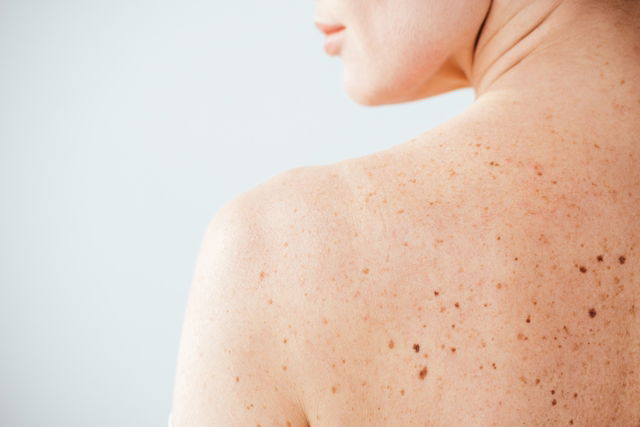Skin discoloration can appear on the face, hands, arms or other parts of the body. It is often caused by excessive sun exposure, hormonal changes, seborrheic keratosis or skin reactions to triggering substances.
However, in more serious cases, skin discoloration can be a sign of skin cancer, which is why it is important to pay attention to characteristics like the spot's symmetry, color and borders.
Whenever the areas affected with skin discoloration increase in size, have different colors or is itchy or flaking, you should see a dermatologist for assessment. The doctor will assess the skin to determine the underlying cause and initiate treatment as appropriate.

The main causes of dark spots on the skin are:
1. Shaving
The use of razors to remove hair can cause irritation in the area, promoting the appearance of spots. They can become darker each time the razor is used. Skin discoloration is most often seen in the armpits and groin
What to do: To lighten the spots caused by shaving, the use of whitening creams or aesthetic treatment may be recommended, according to the dermatologist's prescription.
2. Freckles
Freckles, also called ephelides, are small spots that can appear on the skin, especially on the face and arms. They are brown or reddish in color, and appear due to the increased production of melanin. Freckles usually have a genetic origin, although it is possible for more to appear with excessive sun exposure.
What to do: Freckles do not require treatment, as they do not pose a health risk. However, some people may feel the need to undergo treatment to reduce or lighten freckles for cosmetic reasons. The dermatologist may recommend the use of whitening creams or retinoids, the use of daily sunscreen suitable for the skin type or the carrying out of laser treatment.
3. Sun spots
This is the most common cause of skin discoloration on the the face, arms or legs. It appears due to sun exposure over the years, and is especially common after the age of 45. Normally, these types of spots can become darker over the years if you do not protect your skin daily with sunscreen.
What to do: Exfoliating your skin twice a week can help even the skin tone, however, using a laser or intense pulsed light are good options for evening out skin tone. Furthermore, it is very important to use sunscreen daily to avoid darkening existing spots and to prevent new spots from appearing.
4. Melasma
Melasma is a type of skin discoloration on the face that develops after prolonged periods of sun exposure. This discoloration can also appear after a sunburn, or with pregnancy due to hormonal changes. Melasma related to pregnancy is referred to as chloasma gravidarum.
What to do: Sunscreen should be applied daily to the skin with a minimum SPF of 30. You should avoid prolonged exposure to the sun during the hottest hours. Use a moisturizing cream with vitamin C during pregnancy. If the spots do not lighten on their own after the baby is born, treatments such as laser or diamond peeling or acid peeling can be used.
5. Seborrheic keratosis
Seborrheic keratosis is a type of raised, dark mole that appears on the skin as a result of the natural aging process. It is normally benign, and does not present any type of danger to health.
What to do: Seborrheic keratosis is considered to be a benign condition and does not require specific treatment. However, it is important to consult dermatologist so that the spot and any discoloration can be assessed to rule out the possibility of skin cancer can be ruled out.
6. Acanthosis nigricans
Acanthosis nigricans is a common condition in diabetics, as it is mainly related to insulin resistance. It can also happen as a consequence of polycystic ovary syndrome or metabolic syndrome. This condition is characterized by skin discoloration that is triggered by hormonal imbalances.
What to do: It is important to identify the underlying cause of acanthosis nigricans, as knowing the cause will guide the most appropriate treatment. The doctor may recommend changes to eating habits to ensure normal sugar levels, regular exercise and medications as necessary. You can lighten any skin discoloration by exfoliating the area with liquid soap and sugar once a week.
7. Phytophotomelanosis
Phytophotomelanosis is a type of skin discoloration caused by contact with lemons immediately following sun exposure. The citric acid and vitamin C reacts in the presence of ultraviolet rays from the sun, causing inflammation in the area and leading to to the appearance of discoloration.
What to do: In this case, it is important to wash your skin well with soap and water, apply a cold compress to the area and apply sunscreen. In some cases, the dermatologist may recommend the use of healing ointments.
8. Melanoma
Melanoma is a type of skin cancer that affects melanocytes. These are the skin cells that are responsible for producing melanin, which is the substance that gives the skin its color. The development of this type of skin cancer is promoted by excessive exposure to ultraviolet light from the sun or artificial tanning, resulting in the appearance of a dark spot on the skin with an irregular border that grows over time.
What to do: It is important to have irregular dark spots and skin discoloration assessed by your doctor so that treatment as appropriate can be initiated. Melanoma is typically treated with cryotherapy, immunotherapy, radiation, or chemotherapy, depending on the stage of the cancer.
